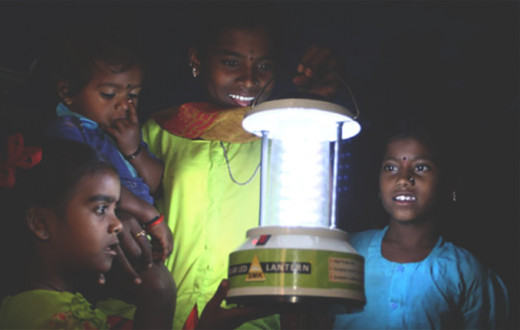“I recently appeared for my board exams and have obtained 84 percent,” says Sunanda. Dressed in a blue skirt and checked shirt, her articulation and clear usage of language might betray you to think of her to be a product of a metropolitan school. Dig a little deeper and you will know that Sunanda is one of the 3,000 first-generation rural children being educated through Art of Living’s tribal welfare projects in Jharkhand. Bringing education to their lives is the passion and dream of Brij Chawla. It's the zeal of this 74-year-old retired engineer to impart education in the lives of the tribals of India that brought him to Ghatshila, where he set up the first Sri Sri Vidya Mandir in 1999.
“Initially, it was a challenge to convince parents to send their kids to school, since it was a loss of one earning member for them,” shares Mr. Chawla. It was this singular purpose of educating the tribal kids that arose in him and led to a movement, which saw the springing up of 20 schools in 14 years in the region. These schools reach out to children from over 100 villages.
Every step of his is in the direction of empowering and giving the children a chance to explore their potential. “The journey has been arduous and exciting,” says Chawla. “We believed that local teachers who understood the ethos of the children were necessary. We experimented by introducing a teacher’s training program with a fun-based learning approach,” he says, while speaking of his innovative approach to overcome the problem of finding teachers in rural areas. Chawla recognized the need of uninhibited child development with a focus on value-based education that laid emphasis on hygiene, culture preservation, non-violence, technology, and environment friendliness. From innovative training programs—especially for teachers—to inculcating responsibility within the children, the schools also provides a platform for vocational training in the inaccessible corners of the country. These schools could very well be the vehicles of rural reform, and Brij Chawla is relentlessly working to achieve this goal.
India's Jharkhand state boasts a huge tribal population and is one of the states struggling with the Naxalite problem. As the place is isolated from neighboring areas, the tribes living there have no exposure to the modern world or latest technology. Very few are able to get proper education, and this is adversely affecting the next generation. This was a major concern for Chawla. The urge to transform these regions compelled him to quit his job 15 years ago. He resigned from the post of General Manager in Bhartiya Cutler Hammer to work towards bringing Naxal-affected tribes into the mainstream.
Today, Chawla has formed a team to work for the children in Naxal-manifested areas. The team’s initiative, coined Small Step on a Long Journey, is a big leap towards development in Jharkhand. Two high schools, one middle school, and fourteen primary schools have come up across the state, imparting free education to 3,000 first-generation school-goers. This is testimony to the team’s resolve to empower the village with modern facilities coupled with a value-based education, as it is an effective aid to their mission of holistic education—a hallmark of Sri Sri Vidya Mandirs all over.
These first-time students are taught their native languages of Mundari and Oraon along with the script Akiki. Mastery over linguistics, semantics, vocabulary, and grammar in one language opens the door to effective communications for their young minds. Once this is done, grasping other languages like Hindi and English becomes comparatively easier.
A Unique Blend of Subjects
For Science and Mathematics, the team has a unique blend that's in consonance with the day-to-day life of the people. For example, the concepts of environment protection, ecological balance, greenhouse gases, and ozone layer depletion are explained through Sarhul festivities (the worship of nature and its flora). This is a unique and innovative way to impart education. The lives of notable tribal personalities like Birsa Munda and Sidhu Kanhu are highlighted in the classes to inculcate a sense of self-esteem as well as respect for tribal culture. Children are inspired to emulate iconic tribal leaders and personalities.
The Art of Living Foundation initiated the tribal project to protect and equip the locals to adapt to the changing world and keep in tune with globalization. Moreover, one of the most effective ways to save the environment is to educate the tribes.
Basic Education
The first step was to impart basic education to first-generation learners without replicating a typical urban school model. The aim was to educate the children and help them become mature individuals who will care for their fellow beings and respect the environment. The curriculum is well-balanced, combining the practical aspects of education in secular languages, arithmetic, moral education, agriculture, yoga, meditation, and games. It includes all the subjects taught at any regular school and aims to develop an individual who really cares and shares.
Imparting education to first-generation learners was started at Sri Sri Vidya Mandirs in 1999. The schools have also become hubs of rural development. Some of their projects include imparting knowledge of zero-budget natural farming to farmers, running technical training centers for the rural youth, conducting free medical camps, and organizing extensive tree plantation drives.
The schools' teachers are chosen from the villages, and each school is equipped with a multimedia room that runs on solar power. The teachers are groomed to understand the value of and provide uninhibited child development with a focus on value-based education, which lays emphasis on hygiene, culture preservation, non-violence, technology, and environment friendliness. Native games like archery, hockey, kabaddi, and soccer find a place in the daily routines of these children. A state-of-the-art computer lab set up with the help of Juniper Networks makes every student full of pride.
An Overview of the Tribal School Project
- 48 percent girls
- 97 percent school attendance
- Dropout rate is below 15 percent
- Over 400 new enrolments every year
- Teachers recruited from local villages
- Teacher's Training Institute set up in Sep 2011
- The Tribal School Project runs 10 schools in Ghatsila block, 3 schools in Dumuria block, 3 schools in the Ranchi block of Jharkhand, and 2 schools in West Bengal
“A school should be a place for uninhibited child development,” says Chawala. “Children in our schools are armed with the knowledge and skills to navigate through mainstream life while celebrating and preserving their unique tribal culture,” he adds.
Chandan, a class IX student of Hindoljuri Middle School says the school is his second home. “Not only has the school provided the education to my three younger sisters and myself, it has also housed and clothed us when our parents passed away.” He aspires to become a teacher to spread the wave of education among other tribal children.








